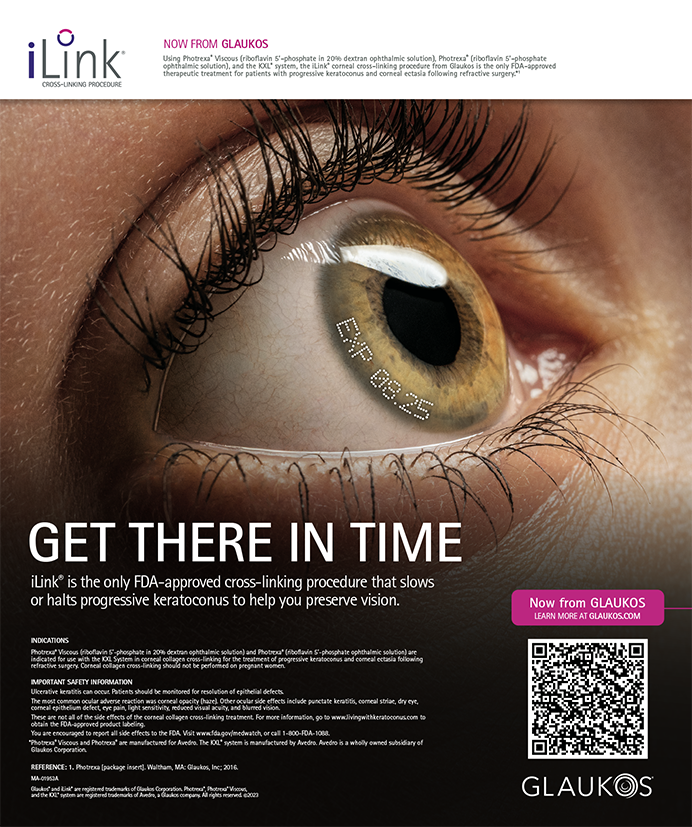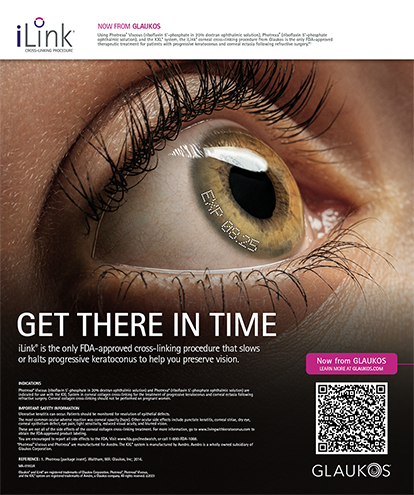Cover Stories | Jul 2005
Combination Therapy for Post-PKP Vision
PRK with adjunctive topical MMC is a safe and effective method for correcting vision after penetrating keratoplasty.
Renée Solomon, MD; Eric D. Donnenfeld, MD; and Henry D. Perry, MD
Although more than 40,000 penetrating keratoplasties (PKPs) are performed each year,1 it is often difficult to improve patients' vision postoperatively due to anisometropia and astigmatism, two common conditions after PKP for keratoconus.2 In these patients, we rely on gas permeable contact lenses to rehabilitate their vision. Many patients are contact lens intolerant, however, due to functional impairment, environmental difficulties, poor manual dexterity, and/or a lack of motivation to wear the lenses. Excimer laser photoablation can restore such patients' vision following PKP,3 but performing LASIK in the presence of post-PKP keratoconus has its risks, because the surgeon makes the lamellar flap in an ectatic recipient bed. Although LASIK may be an option if the patients have preexisting corneal ectasia, they are more likely to develop corneal ectasia and recurrent keratoconus in the graft.
PRK after PKP commonly results in corneal haze, which limits the effectiveness of the procedure.4 However, investigators have identified mitomycin C (MMC) as a safe and effective treatment to prevent this complication.5,6 To our knowledge, no reports in the peer-reviewed literature evaluate the adjunctive use of MMC with PRK in patients after PKP. During the past 2 years, we have investigated the efficacy and safety of adjunctive topical MMC in combination with PRK for treating refractive errors in post-PKP patients with keratoconus.7
METHODS
All patients underwent PKP for keratoconus, had their sutures removed for a minimum of 3 months before being enrolled in the study, and were contact lens intolerant. The same surgeon performed the procedures using the Visx Star S4 laser (Visx, Incorporated, Santa Clara, CA) or the Technolas (Bausch & Lomb, Rochester, NY). After PRK photoablation, the surgeon applied 0.02% MMC to the corneal stromal beds for 2 minutes using a Merocel sponge (Medtronic Merocel, Mystic, CT). Patients used a bandage contact lens until the epithelium closed. Topical ofloxacin 0.3% was applied q.i.d. for 5 days; topical prednisolone acetate 1% was applied q.i.d. for 2 weeks, t.i.d. for 2 weeks, b.i.d. for 2 weeks, and q.d. for 2 weeks; and topical ketorolac tromethamine 0.5% was applied q.i.d. for 2 days. We followed the subjects until their epithelium closed and then at 1 week, 1 month, 3 months, and 6 months.
PARAMETERS
We enrolled 10 patients (11 eyes) in our study. The six males and four females had a mean age of 36 years. Ten eyes were myopic, and one was hyperopic. UCVA before PRK was 20/100 in one eye, 20/200 in two eyes, 20/400 in three eyes, and count fingers in five eyes. BSCVA before PRK was 20/20 in three eyes, 20/25 in five eyes, 20/30 in one eye, 20/40 in one eye, and 20/50 in one eye. The mean preoperative refraction for the 10 myopic eyes was -5.96 ±3.02D. The preoperative refraction for the hyperopic patient was +7.00 -4.75 X 1.25 = 20/25. The preoperative spherical equivalent for this patient was +4.63D.
RESULTS
Postoperative BSCVA ranged from 20/20 to 20/30. All eyes maintained corneal clarity with no loss of BSCVA, corneal haze, or adverse reaction to the corneal button. Additionally, there were no scarring or healing abnormalities. At 6 months postoperatively, the myopic eyes' mean postoperative refraction was -1.00 ±0.72D (spherical equivalent) and 0.60 ±0.52D (cylinder). For the hyperopic eye, at 6 months postoperatively, the mean refraction was -0.25 -0.25 X 165 = 20/20, and the spherical equivalent was -0.32D.
CONCLUSION
According to our study, intraoperative MMC appears to be a safe and effective method for visual rehabilitation and for the prevention of postoperative haze in keratoconic eyes after PKP. A low dose of MMC applied directly to the stromal bed avoids toxicity to limbal stem cells, and there have been no reports of any deleterious effects to the cornea. Complications of MMC may occur as long as a decade following surgery, so long-term follow-up is mandatory.
Editor's Note: The authors were awarded first place at the World Cornea Congress V for their scientific poster presentation.7
Renée Solomon, MD, is an ophthalmology fellow at Ophthalmic Consultants of Long Island in New York. She states that she holds no financial interest in any product or company mentioned herein. Dr. Solomon may be reached at rensight@yahoo.com.
Eric D. Donnenfeld, MD, is a partner at Ophthalmic Consultants of Long Island and is Co-Chairman of Cornea and External Disease at the Manhattan Eye, Ear, and Throat Hospital in New York. He states that he holds no financial interest in any product or company mentioned herein.
Dr. Donnenfeld may be reached at (516) 766-2519; eddoph@aol.com.
Henry D. Perry, MD, is a partner at Ophthalmic Consultants of Long Island and serves as Clinical Associate Professor of Ophthalmology at the Weil Cornell School of Medicine in Manhattan; Chief of the Cornea Service at Nassau University Medical Center in East Meadow, New York; and Medical Director of the Lion's Eyebank of Long Island in New York. He states that he holds no financial interest in any product or company mentioned herein. Dr. Perry may be reached at (516) 766-2519; hankcornea@aol.com.
1. Eye Bank Association of America. Statistical report available at: http://www.restoresight.org/general/publications.htm. Accessed June 9, 2005.
2. Pert T, Charlton KH, Binder PS. Disparate diameter grafting. Astigmatism, intraocular pressure, and visual acuity. Ophthalmology. 1981;88:774-781.
3. Donnenfeld ED, Solomon R, Biser S. Laser in situ keratomileusis after penetrating keratoplasty. Int Ophthalmol Clin. 2002;42:67-87.
4. Bilgihan K, Ozdek SC, Akata F, Hasanreisoglu B. Photorefractive keratectomy for post-penetrating keratoplasty myopia and astigmatism. J Cataract Refract Surg. 2000;26:1590-1595.
5. Carones F, Vigo L, Scandola E, Vacchini L. Evaluation of the prophylactic use of mitomycin-C to inhibit haze formation after photorefractive keratectomy. J Cataract Refract Surg. 2002;28:2088-2095.
6. Majmudar PA, Forstot SL, Dennis RF, et al. Topical mitomycin-C for subepithelial fibrosis after refractive corneal surgery. Ophthalmology. 2000;107:89-94.
7. Solomon R, Donnenfeld E, Perry H. Management of refractive errors following penetrating keratoplasty with photorefractive keratectomy and adjunctive mitomycin C. Poster presented at: The World Cornea Congress; April 15, 2005; Washington, DC.


